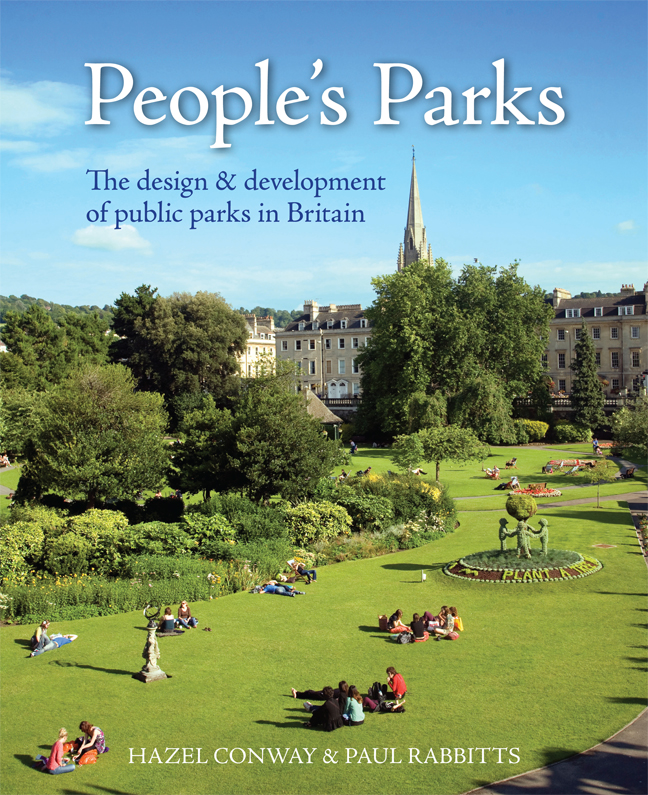Book contents
- Frontmatter
- Dedication
- Contents
- Miscellaneous Frontmatter
- Preface
- Acknowledgements
- Foreword
- A Word from Parks Professionals, Politicians and Parks Organisations
- Introduction: Dr Hazel Conway (1991)
- 1 Public Parks and Municipal Parks
- 2 The Need for Parks
- 3 Pioneering Parks Development
- 4 The Park Movement
- 5 Design and Designers
- 6 Lodges, Bandstands and the Cultivation of Virtue
- 7 Local Pride and Patriotism
- 8 Planting and Park Maintenance
- 9 Permitted Pastimes
- 10 Recreation Grounds, Parks and the Urban Environment
- 11 Public Parks, 1885–1914
- 12 Later Municipal Park Designers
- 13 Garden Cities and the New Towns Movement
- 14 Sport, Physical Activity and Recreation in Public Parks in the Inter-war Years
- 15 Parks Management – a Changing Perspective
- 16 Decline, Revival and Renewal – the Role of Parks into 21st-century Britain
- Appendix 1 Summary of main legislation promoting early park development
- Appendix 2 Chronology of main municipal and public park developments between 1800 and 1885
- Notes
- Bibliography
- Subscription List
- Index
Foreword
Published online by Cambridge University Press: 22 February 2024
- Frontmatter
- Dedication
- Contents
- Miscellaneous Frontmatter
- Preface
- Acknowledgements
- Foreword
- A Word from Parks Professionals, Politicians and Parks Organisations
- Introduction: Dr Hazel Conway (1991)
- 1 Public Parks and Municipal Parks
- 2 The Need for Parks
- 3 Pioneering Parks Development
- 4 The Park Movement
- 5 Design and Designers
- 6 Lodges, Bandstands and the Cultivation of Virtue
- 7 Local Pride and Patriotism
- 8 Planting and Park Maintenance
- 9 Permitted Pastimes
- 10 Recreation Grounds, Parks and the Urban Environment
- 11 Public Parks, 1885–1914
- 12 Later Municipal Park Designers
- 13 Garden Cities and the New Towns Movement
- 14 Sport, Physical Activity and Recreation in Public Parks in the Inter-war Years
- 15 Parks Management – a Changing Perspective
- 16 Decline, Revival and Renewal – the Role of Parks into 21st-century Britain
- Appendix 1 Summary of main legislation promoting early park development
- Appendix 2 Chronology of main municipal and public park developments between 1800 and 1885
- Notes
- Bibliography
- Subscription List
- Index
Summary
My mother, Dr Hazel Conway, was born on 28 April 1933. Her mother, Kathleen Barham, was a chiropodist. Her Austrian father, Emil Oesterly, was a merchant banker, and at the outbreak of the Second World War returned home to fight as an officer. During the war, Hazel was evacuated to the country to live with her English grandmother. Granny took her responsibilities very seriously and was extremely strict. Granny also took the opportunity to teach Hazel as much as she could while she was in her care – especially maths and science. This ensured Hazel had confidence and was well ahead of the other children when she eventually went to school.
After the war Hazel returned to her mother in Watford, who by this time was divorced. Aged 18, Hazel visited Austria – hoping to reunite with her father and his new family. Sadly this came to nothing; but while there she had a serious car accident. With a badly broken leg, Hazel spent months in a little cottage hospital, ending up with a permanent limp. Never one to feel sorry for herself, Hazel used the time while convalescing to teach English to local people.
After studying physics at Reading University, Hazel's first job was working at Battersea Power Station as a librarian and information officer. She then became the first woman journalist on Fleet Street – a technical journalist writing for Scientific Instruments. Hazel regularly had to attend the many large lunches given for journalists. Afterwards the men would retire to a smoking room … and Hazel simply joined them!
While still living in London, she took a post that required commuting to Leicester to teach liberal studies at the polytechnic – which in 1992 became De Montfort University. By the early 1970s all practical art and design students had to pass in associated historical studies alongside their main subject. While art and architectural history were long established, new subjects were evolved to cover the many branches of design. The teaching expertise gradually acquired and developed in both these old and new subjects encouraged many institutions to establish their own single honours art history degree programmes. In 1975 Mary Stewart initiated such a course.
Treating the subject in a democratic way, Mary and her team opened it up so that it was accessible to everyone, and from the outset it must have been one of the broadest degree programmes in the country.
- Type
- Chapter
- Information
- People's ParksThe design & development of public parks in Britain, pp. xi - xiiPublisher: Boydell & BrewerPrint publication year: 2023



